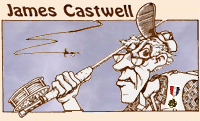|
Well, maybe it does, maybe not; but it might. I was
just reading a fine article on a new way to do a
'Roll-Cast,' fine job and the author was right on
the button. It got me to thinking about a few things
about that cast though.
Shortly after man invented a fly rod he needed the
roll-cast. Even long before he invented a fly reel.
With the string tied to the end there were only a
few ways to present a fly, one of which was to
lengthen the string, get it out in front of him,
sweep it in an arc behind him a bit, whip it forward
in a big circle and low and behold, the line formed
a big loop and 'rolled' out in front of him and with
it the fly. Eureka, the cast lived, and still lives
today, done by most exactly the same way.
You see, that method (also swiped by the guy who also
invented 'Spey-casting') is how many learn it today,
read about in books and see done most of the time on
the streams and lakes. I'm not going to say it is
'wrong,' but it sure is an ineffectual way of doing
things, ineffectual that is if you have any rod other
than a medium or soft rod.
It is often called 'chopping of the head of a turkey.'
The motion is about the same. Chop down with the rod,
the line rolls out and you think you have done your job.
But, there is a another way of doing it. It did not exist
in years gone by.
The faster rods offered today will make the cast possible
though. Try this sometime. By the way, I see a few are
putting new names on it now, but I will not do so here.
Just try this. Remember, a good forward cast depends on
a good back-cast, right? If you agree with that, get out
about forty feet of fly line (with a leader too), pull
in a few feet with your left hand, raise the rod to about
one o'clock (that's about one hour behind your head) and
stop it there. This should leave only a few feet of line
on the water.
Now, make a hard forward cast. NOT a ROLL CAST. I
mean, stop the rod at about ten o'clock in front of you.
As the line shoots out, it will jump up from the water,
form a hoop in the air and keep going. If you want even
more distance just rip a little double-haul into it as
it is forming. The object there is to get the loop to
form in the air, not on the water.
It takes a medium-fast rod or better to make this happen,
the soft ones will not put enough power into the cast to
make it get off the water.
Aw, nuts, let's call this the J. Castwell
'Up-Jumping-Rolling-in-the-air-Shooting-way-out-there-forward-airialized-cast'.
You're welcome. (Yes, I know some call this the basic
spey-cast, tough.)
~ James Castwell
|



